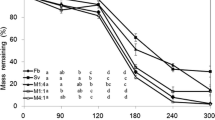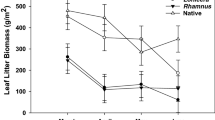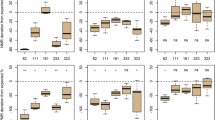Abstract
Leaf traits related to the performance of invasive alien species can influence nutrient cycling through litter decomposition. However, there is no consensus yet about whether there are consistent differences in functional leaf traits between invasive and native species that also manifest themselves through their “after life” effects on litter decomposition. When addressing this question it is important to avoid confounding effects of other plant traits related to early phylogenetic divergences and to understand the mechanism underlying the observed results to predict which invasive species will exert larger effects on nutrient cycling. We compared initial leaf litter traits, and their effect on decomposability as tested in standardized incubations, in 19 invasive-native pairs of co-familial species from Spain. They included 12 woody and seven herbaceous alien species representative of the Spanish invasive flora. The predictive power of leaf litter decomposition rates followed the order: growth form > family > status (invasive vs. native) > leaf type. Within species pairs litter decomposition tended to be slower and more dependent on N and P in invaders than in natives. This difference was likely driven by the higher lignin content of invader leaves. Although our study has the limitation of not representing the natural conditions from each invaded community, it suggests a potential slowing down of the nutrient cycle at ecosystem scale upon invasion.

Similar content being viewed by others
References
Abrams MM, Jarrell WM (1992) Bioavailability index for phosphorous using ion-exchange resin impregnated membranes. Soil Sci Soc Am J 56:1532–1537
Allison SD, Vitousek PM (2004) Rapid nutrient cycling in leaf litter from invasive plants in Hawaii. Oecologia 141:612–619
Armstrong DP, Westoby M (1993) Seedlings from large seeds tolerate defoliation better—a test using phylogenetically independent contrast. Ecology 74:1092–1100
Ashton IW, Hyatt LA, Howe KM, Gurevitch J, Lerdau MT (2005) Invasive species accelerate decomposition and litter nitrogen loss in a mixed deciduous forest. Ecol Appl 15:1263–1272
Bousquet-Melou A, Louis S, Robles C, Greff S, Dupouyet S, Fernandez C (2005) Allelopathic potential of Medicago arborea, a Mediterranean invasive shrub. Chemoecology 15:193–198
Bremer B, et al (2003) An update of the Angiosperm Phylogeny Group classification for the orders and families of flowering plants: APG II. Bot J Linn Soc 141:399–436
Bubb KA, Xu ZH, Simpson JA, Saffigna PG (1998) Some nutrient dynamics associated with litterfall and litter decomposition in hoop pine plantations of southeast Queensland, Australia. For Ecol Manage 110:343–352
Burnham KP, Anderson DR (2002) Model selection and multimodel inference. Springer, New York
Castro-Díez P, González-Muñoz N, Alonso A, Gallardo A, Poorter L (2009) Effects of exotic invasive trees on nitrogen cycling: a case study in Central Spain. Biol Invasions 11:1973–1986
Castroviejo S (1986–2008) Flora Ibérica. Plantas vasculares de la Península Ibérica e Islas Baleares. (todos los vols). Real Jardín Botánico-CSIC, Madrid
Chigineva NI, Aleksandrova AV, Tiunov AV (2009) The addition of labile carbon alters litter fungal communities and decreases litter decomposition rates. Appl Soil Ecol 42:264–270
Cornelissen JHC (1996) An experimental comparison of leaf decomposition rates in a wide range of temperate plant species and types. J Ecol 84:573–582
Cornwell WK, et al (2008) Plant species traits are the predominant control on litter decomposition rates within biomes worldwide. Ecol Lett 11:1065–1071
Cotrufo MF, Briones MJI, Ineson P (1998) Elevated CO2 affects field decomposition rate and palatability of tree leaf litter: importance of changes in substrate quality. Soil Biol Biochem 30:1565–1571
Di Tomaso JM (1998) Impact, biology and ecology of saltcedar (Tamarix spp.) in the southwestern United States. Weed Technol 12:326–336
Drenovsky RE, Batten KM (2007) Invasion by Aegilops triuncialis (barb goatgrass) slows carbon and nutrient cycling in a serpentine grassland. Biol Invasions 9:107–116
Dukes JS, Mooney HA (2004) Disruption of ecosystem processes in western North America by invasive species. Rev Chil Hist Nat 77:411–437
Ehrenfeld JG (2003) Effects of exotic plant invasions on soil nutrient cycling processes. Ecosystems 6:503–523
Epstein E (1994) The anomaly of silicon in plant biology. Proc Natl Acad Sci USA 91:11–17
Fowler J, Cohen L (1992) Practical statistics for field biology. Wiley, London
Gallardo A, Merino J (1992) Nitrogen immobilization in leaf litter at two Mediterranean ecosystems of SW Spain. Biogeochemistry 15:213–228
Gallardo A, Merino J (1993) Leaf decomposition in two Mediterranean ecosystems of southwest Spain, influence of substrate quality. Ecology 74:152–161
Gallardo A, Parama R (2007) Spatial variability of soil elements in two plant communities of NW Spain. Geoderma 139:199–208
Garnier E, et al (2004) Plant functional markers capture ecosystem properties during secondary succession. Ecology 85:2630–2637
Gasso N, et al (2009) Exploring species attributes and site characteristics to assess plant invasions in Spain. Divers Distrib 15:50–58
Hättenschwiler S, Vitousek PM (2000) The role of polyphenols in terrestrial ecosystem nutrient cycling. Trends Ecol Evol 15:238–243
Hobbie SE (1992) Effects of plant-species on nutrient cycling. Trends Ecol Evol 7:336–339
Knight KS, Kurylo JS, Endress AG, Stewart JR, Reich PB (2007) Ecology and ecosystem impacts of common buckthorn (Rhamnus cathartica): a review. Biol Invasions 9:925–937
Knorr M, Frey SD, Curtis PS (2005) Nitrogen additions and litter decomposition: a meta-analysis. Ecology 86:3252–3257
Kolar CS, Lodge DM (2001) Progress in invasion biology: predicting invaders. Trends Ecol Evol 16:199–204
Kueffer C, Klingler G, Zirfass K, Schumacher E, Edwards PJ, Gusewell S (2008) Invasive trees show only weak potential to impact nutrient dynamics in phosphorus-poor tropical forests in the Seychelles. Funct Ecol 22:359–366
Lautner S, Ehlting B, Windeisen E, Rennenberg H, Matyssek R, Fromm J (2007) Calcium nutrition has a significant influence on wood formation in poplar. New Phytol 173:743–752
Levine JM, Vila M, D’Antonio CM, Dukes JS, Grigulis K, Lavorel S (2003) Mechanisms underlying the impacts of exotic plant invasions. Proc R Soc Lond B Biol Sci 270:775–781
Liao CZ, et al (2008) Altered ecosystem carbon and nitrogen cycles by plant invasion: a meta-analysis. New Phytol 177:706–714
Mack RN, Simberloff D, Lonsdale WM, Evans H, Clout M, Bazzaz FA (2000) Biotic invasions: causes, epidemiology, global consequences, and control. Ecol Appl 10:689–710
Manders PT, Richardson DM (1992) Colonization of Cape fynbos communities by forest species. For Ecol Manage 48:277–293
Marko PD, Gross EM, Newman RM, Gleason FK (2008) Chemical profile of the North American native Myriophyllum sibiricum compared to the invasive M. spicatum. Aquat Bot 88:57–65
Poorter H, Villar R (1997) The fate of acquired carbon in plants: chemical composition and construction costs. In: Bazzaz FA, Grace J (eds) Plant resource allocation. Academic Press, San Diego, pp 39–72
Pyšek P, Richardson DM (2007) Traits associated with invasiveness in alien plants: where do we stand? In: Caldwell MM (ed) Biological invasions, vol 193. Springer, Berlin Heidelberg, pp 97–125
Pyšek P, Richardson DM, Rejmánek M, Webster GL, Williamson M, Kirschner J (2004) Alien plants in checklist and floras: towards better communication between taxonomist and ecologist. Taxon 53:131–143
Quested HM, et al (2003) Decomposition of sub-arctic plants with differing nitrogen economies: a functional role for hemiparasites. Ecology 84:3209–3221
Quested HM, Callaghan TV, Cornelissen JHC, Press MC (2005) The impact of hemiparasitic plant litter on decomposition: direct, seasonal and litter mixing effects. J Ecol 93:87–98
R Development Core Team (2009) R: a language and environment for statistical computing. R foundation for Statistical Computing, Vienna. ISBN 3-900051-07-0. http://www.R-project.org
Richardson DM, Pyšek P, Rejmanek M, Barbour MG, Panetta FD, West CJ (2000) Naturalization and invasion of alien plants: concepts and definitions. Divers Distrib 6:93–107
Rubio A, Escudero A (2005) Effect of climate and physiography on occurrence and intensity of decarbonation in Mediterranean forest soils of Spain. Geoderma 125:309–319
Sanz Elorza M, Dana Sanchez D, Sobrino Vesperinas E (2004) Atlas de las Plantas Alóctonas Invasoras en España. Ministerio de Medio Ambiente, Madrid
Sayer EJ (2006) Using experimental manipulation to assess the roles of leaf litter in the functioning of forest ecosystems. Biol Rev 81:1–31
Sims GK, Ellsworth TR, Mulvaney RL (1995) Microscale determination of inorganic nitrogen in water and soil extracts. Commun Soil Sci Plant Anal 26:303–316
Sneller FEC, et al (1999) Toxicity of arsenate in Silene vulgaris, accumulation and degradation of arsenate-induced phytochelatins. New Phytol 144:223–232
Soltis DE, et al (2000) Angiosperm phylogeny inferred from 18S rDNA, rbcL, and atpB sequences. Bot J Linn Soc 133:381–461
Strauss SY, Webb CO, Salamin N (2006) Exotic taxa less related to native species are more invasive. Proc Natl Acad Sci USA 103:5841–5845
Subler S, Blair JM, Edwards CA (1995) Using anion-exchange membranes to measure soil nitrate availability and net nitrification. Soil Biol Biochem 27:911–917
Swift MJ, Heal OW, Anderson JM (1979) Decomposition in terrestrial ecosystems. In: Studies in ecology, vol 5. Blackwell, Oxford
Valéry L, Fritz H, Lefeuvre JC, Simberloff D (2008) In search of a real definition of the biological invasion phenomenon itself. Biol Invasions 10:1345–1351
Villar R, Robleto JR, De Jong Y, Poorter H (2006) Differences in construction costs and chemical composition between deciduous and evergreen woody species are small as compared to differences among families. Plant Cell Environ 29:1629–1643
Vitousek PM, Howarth RW (1991) Nitrogen limitation on land and in the sea—how can it occur? Biogeochemistry 13:87–115
Xuluc-Tolosa FJ, Vester HFM, Ramirez-Marcial N, Castellanos-Albores J, Lawrence D (2003) Leaf litter decomposition of tree species in three successional phases of tropical dry secondary forest in Campeche, Mexico. For Ecol Manage 174:401–412
Yelenik SG, Stock WD, Richardson DM (2007) Functional group identity does not predict invader impacts: differential effects of nitrogen-fixing exotic plants on ecosystem function. Biol Invasions 9:117–125
Acknowledgements
Thanks are due to Margarita Costa-Tenorio, Antonio Gallardo, Rob Broekman and Manuel Godoy for field help, supplying ion exchange resin membranes and lab assistance, respectively. Financial support was provided by the Spanish Ministry for Education and Science grants RASINV GL2004-04884-C02 02/BOS (as part of the coordinate project RINVE) and CGL2007-61873/BOS.
Author information
Authors and Affiliations
Corresponding author
Additional information
Communicated by Stephan Hattenschwiler.
Electronic supplementary material
Below is the link to the electronic supplementary material.
Rights and permissions
About this article
Cite this article
Godoy, O., Castro-Díez, P., Van Logtestijn, R.S.P. et al. Leaf litter traits of invasive species slow down decomposition compared to Spanish natives: a broad phylogenetic comparison. Oecologia 162, 781–790 (2010). https://doi.org/10.1007/s00442-009-1512-9
Received:
Accepted:
Published:
Issue Date:
DOI: https://doi.org/10.1007/s00442-009-1512-9




